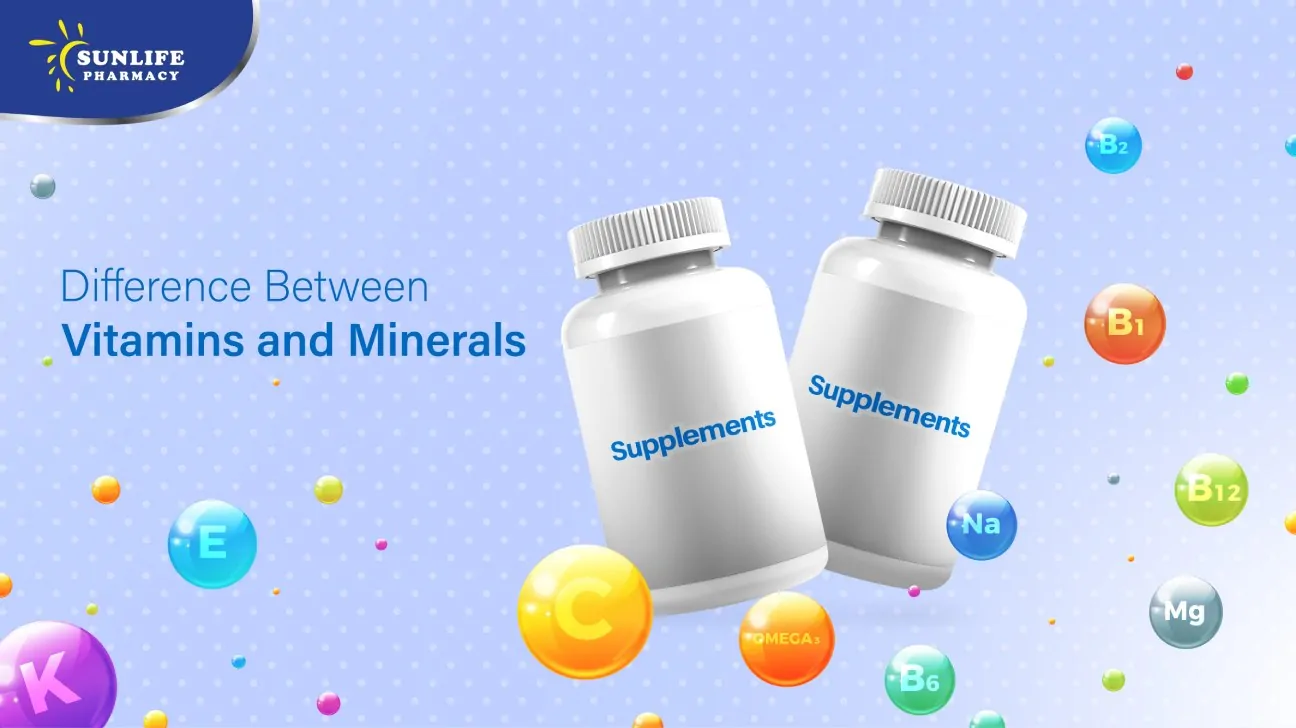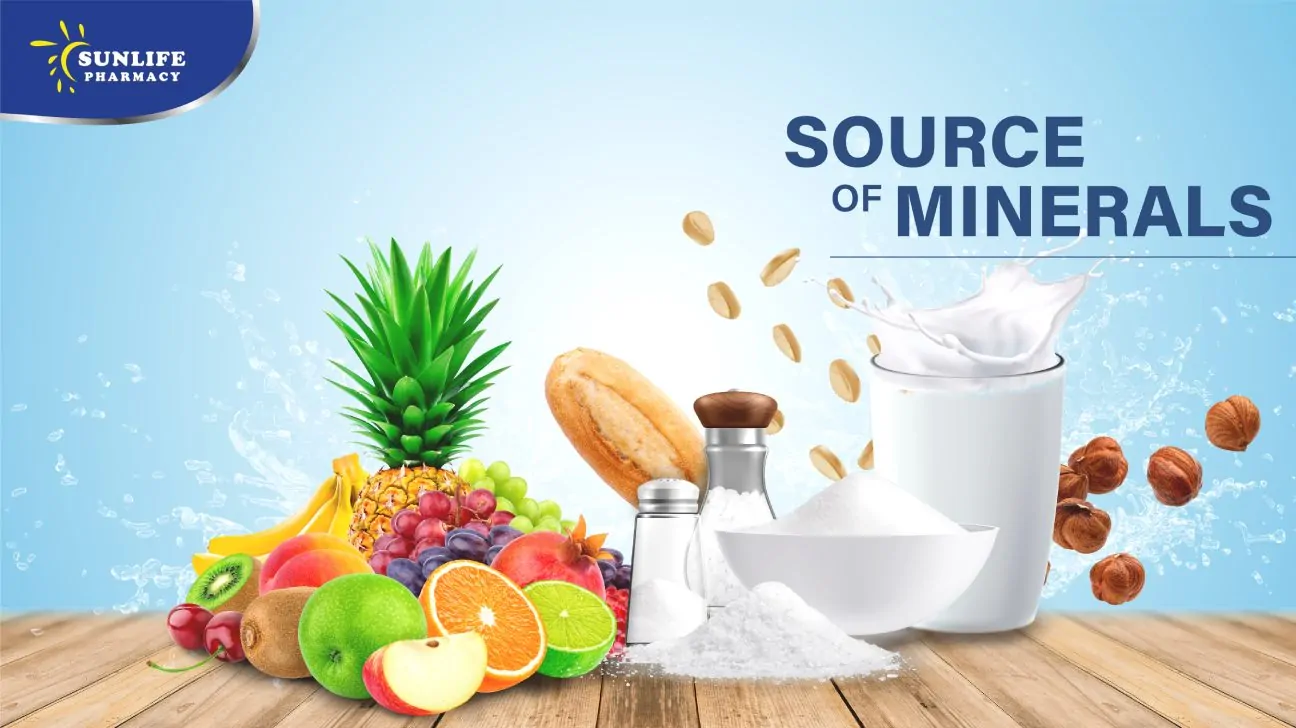Difference Between Vitamins and Minerals

Vitamins are substances that the body needs to function. There are 13 essential vitamins, which can either be fat-soluble or water-soluble. Vitamins are found in a variety of foods or can be taken as a supplement. Too much or too little of any vitamin can cause health problems.

Like vitamins, your body needs minerals to function. While there are only 13 essential vitamins, there are thousands of known minerals. Your body doesn’t necessarily need all of them, but it does need certain minerals to function properly. Depending on the mineral, you might need large or small amounts. Minerals are found in a variety of foods, and like vitamins, too much or too little can cause health issues.
Vitamins
Vitamins are substances that are needed for normal cell function, growth, and development. Each vitamin plays an important role in the body. When you don’t get enough of a certain vitamin, you may become deficient. Vitamin deficiency can cause health problems and may increase your risk of heart disease, cancer, and osteoporosis. Getting the right amount of vitamins can help boost your immunity and maintain optimal health.
There are 13 vitamins:
- Vitamin A (retinol)
- Vitamin C (ascorbic acid)
- Vitamin D
- Vitamin E (tocopherol)
- Vitamin K
- Vitamin B1 (thiamine)
- Vitamin B2 (riboflavin)
- Vitamin B3 (niacin)
- Vitamin B5 (pantothenic acid)
- Vitamin B6 (pyridoxine)
- Vitamin B7 (biotin)
- Vitamin B9 (folate)
- Vitamin B12 (cobalamin)
Type of Vitamins
Vitamins are grouped into two categories: fat-soluble and water-soluble. Fat-soluble vitamins are stored in the body’s fatty tissues. There are four fat-soluble vitamins: A, D, E, and K. These vitamins are absorbed more easily when consumed with a bit of dietary fat. Water-soluble vitamins are used by the body right away. They are not stored by the body and have to be regularly consumed. Any leftover water-soluble vitamins are excreted in the urine. Vitamin C and the B-vitamins are water-soluble. Vitamin B12 is the exception because it can be stored in the liver for many years.
Difference Between Fat Soluble and Water Soluble
Functions and Sources of Vitamins
Each of the 13 vitamins plays a specific role in the body. It’s important to get enough of each vitamin to maintain optimal health.
- Vitamin A (retinol) helps form and maintain healthy teeth, bones, soft tissue, mucus membranes, and skin. Vitamin A is found in dark-colored fruit, dark leafy vegetables, eggyolks, fortified milk and dairy products (cheese, yogurt, butter, and cream), and meats such as liver, beef, and fish.
- Vitamin C (ascorbic acid) is an antioxidant that supports healthy teeth and gums. It helps the body absorb iron and maintain healthy tissue. This vitamin is also considered to have immunity-boosting properties, as it helps wounds to heal. Vitamin C is found in citrus fruits and other vegetables including broccoli, brussels sprouts, cabbage, cauliflower, potatoes, spinach, and tomatoes.

- Vitamin D is known as the “sunshine vitamin” because the body produces it after sun exposure. Depending on location and skin pigmentation, the body only needs 10 to 15 minutes of sunshine a few times a week to produce all of the vitamin D it needs to function. It is a fat-soluble vitamin that helps the body absorb calcium, a mineral required for the development and maintenance of healthy teeth and bones.
- Vitamin E (tocopherol) is an antioxidant that helps the body form red blood cells and also allows for the use of Vitamin K. Vitamin E is found in avocado, dark green vegetables (spinach, broccoli, asparagus, and turnip greens), oils (safflower, corn, and sunflower), papayas, mangos, nuts and seeds, and wheat germ.
- Vitamin K is essential for blood coagulation and may also support bone health.
- Vitamin K is found in cabbage, cauliflower, cereals, dark green vegetables (broccoli, Brussels sprouts, and asparagus), dark leafy vegetables (spinach, kale, collards, and turnip greens), and meat products such as fish, liver, beef, and eggs.
- Vitamin B1 (thiamine) helps cells convert carbohydrates into energy. This vitamin also supports heart function and healthy nerve cells. Thiamine is found in dried milk, eggs, enriched breads, lean meats, legume, nuts and seeds, organ meats, peas, and whole grains.
- Vitamin B2 (riboflavin) works with the other B-vitamins. It is important for body growth and red blood cell production. Riboflavin is found in asparagus, broccoli, eggs, kidneys, lean meats, liver, low-fat milk, and spinach.
- Vitamin B3 (niacin) helps maintain healthy skin and nerves. It can also help lower cholesterol. Niacin is found in avocado, eggs, enriched breads and fortified cereals, fish, lean meats, legumes, nuts, potatoes, and poultry.
- Vitamin B5 (pantothenic acid) is essential for the metabolism of food. It also assists in the production of hormones. Pantothenic acid is found in avocados, broccoli, eggs, kale, legumes and lentils, milk, mushrooms, organ meats, potatoes, poultry, and whole-grain cereals.
- Vitamin B6 (pyridoxine) helps produce red blood cells and maintain brain function. Because this vitamin plays a role in the proteins that are part of many chemical reactions in the body, your body requires more of it when you eat more protein. Pyroxidine is found in avocado, bananas, legumes, meat, nuts, poultry, and whole grains.
- Vitamin B7 (biotin) is essential for the metabolism of proteins and carbohydrates and supports healthy hair, skin, and nails. It also assists in hormone production. Biotin is found in chocolate, cereal, egg yolks, legumes, milk, nuts, organ meats, pork, and yeast.
- Vitamin B9 (folate) works with vitamin B12 in red blood cell production, It also plays a role in the production of DNA. Folate is especially important for pregnant women, as a deficiency can cause birth defects. While many foods are now fortified with folic acid (a form of folate), folate can be found naturally in asparagus, beets, broccoli, dried beans, leafy green vegetables, lentils, oranges, peanut butter, and wheat germ.
- Vitamin B12 (cobalamin) helps support metabolism, red blood cell production, and the central nervous system. Cobalamin is found in animal sources such as eggs, meat, milk, organ meats, poultry, and shellfish.
Recommended Dietary Allowances (RDA)
The Recommended Dietary Allowance (RDA) for each vitamin indicates how much of each vitamin most people should get each day. While the RDA for vitamins may be used as a goal, how much of each vitamin you need depends on factors such as your age, gender, and health. More is not always better, as high doses of certain vitamins can be toxic. This is especially true for fat-soluble vitamins (A, D, E, and K), which are stored in fat cells and can build up in the body. Talk to your healthcare provider about your vitamin needs.
Minerals
Minerals are naturally occurring substances that are essential for building bones, making hormones, regulating your heartbeat, and supporting healthy muscles and brain function.

Minerals can be classified as macrominerals or trace minerals. Macrominerals are needed in larger amounts:
- Calcium
- Phosphorus
- Magnesium
- Sodium
- Potassium
- Chloride
- Sulfur
Trace minerals are needed in small amounts
- Iron
- Manganese
- Copper
- Iodine
- Zinc
- Cobalt
- Fluoride
- Selenium
The best way to get the minerals your body needs is by eating a wide variety of foods. Minerals have certain functions in the body and can be found in a variety of food sources.Some minerals serve electrolytes. The body uses electrolytes to help regulate nerve and muscle function. Electrolytes are also used to maintain acid-base balance and water balance. Certain disorders can develop if the electrolyte balance is disrupted.


